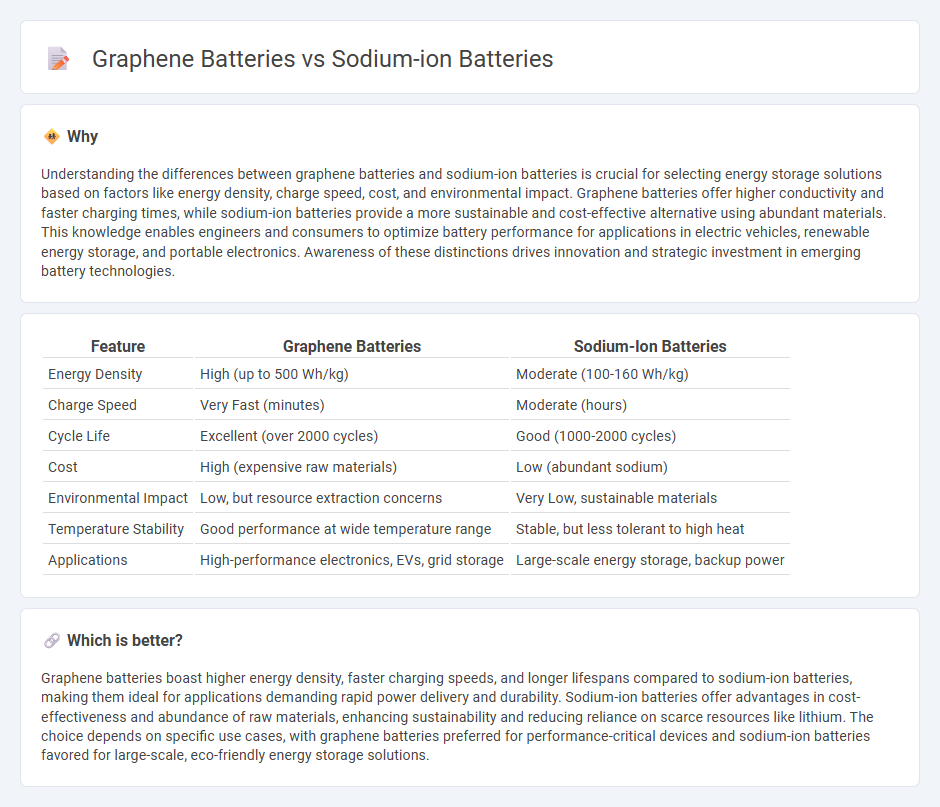
Graphene batteries offer higher conductivity, faster charging times, and longer lifespans compared to traditional lithium-ion batteries, enhancing performance for electric vehicles and portable electronics. Sodium-ion batteries present a cost-effective alternative with abundant raw materials, improved safety, and stable cycling capabilities, making them suitable for large-scale energy storage systems. Explore the advancements and applications of these cutting-edge battery technologies to understand their impact on the future of energy storage.
Why it is important
Understanding the differences between graphene batteries and sodium-ion batteries is crucial for selecting energy storage solutions based on factors like energy density, charge speed, cost, and environmental impact. Graphene batteries offer higher conductivity and faster charging times, while sodium-ion batteries provide a more sustainable and cost-effective alternative using abundant materials. This knowledge enables engineers and consumers to optimize battery performance for applications in electric vehicles, renewable energy storage, and portable electronics. Awareness of these distinctions drives innovation and strategic investment in emerging battery technologies.
Comparison Table
| Feature | Graphene Batteries | Sodium-Ion Batteries |
|---|---|---|
| Energy Density | High (up to 500 Wh/kg) | Moderate (100-160 Wh/kg) |
| Charge Speed | Very Fast (minutes) | Moderate (hours) |
| Cycle Life | Excellent (over 2000 cycles) | Good (1000-2000 cycles) |
| Cost | High (expensive raw materials) | Low (abundant sodium) |
| Environmental Impact | Low, but resource extraction concerns | Very Low, sustainable materials |
| Temperature Stability | Good performance at wide temperature range | Stable, but less tolerant to high heat |
| Applications | High-performance electronics, EVs, grid storage | Large-scale energy storage, backup power |
Which is better?
Graphene batteries boast higher energy density, faster charging speeds, and longer lifespans compared to sodium-ion batteries, making them ideal for applications demanding rapid power delivery and durability. Sodium-ion batteries offer advantages in cost-effectiveness and abundance of raw materials, enhancing sustainability and reducing reliance on scarce resources like lithium. The choice depends on specific use cases, with graphene batteries preferred for performance-critical devices and sodium-ion batteries favored for large-scale, eco-friendly energy storage solutions.
Connection
Graphene batteries and sodium-ion batteries are connected through their shared goal of advancing energy storage technology by enhancing battery performance and sustainability. Both utilize innovative materials--graphene enhances conductivity and cycle life in lithium-ion variants, while sodium-ion batteries use abundant sodium for cost-effective, eco-friendly alternatives. Their development represents a shift towards high-efficiency, durable batteries crucial for electric vehicles and renewable energy systems.
Key Terms
Energy Density
Sodium-ion batteries typically offer an energy density of around 150-200 Wh/kg, making them a cost-effective and sustainable alternative to lithium-ion batteries. Graphene batteries, enhanced with graphene's high conductivity and surface area, can achieve energy densities exceeding 300 Wh/kg, providing faster charging and longer cycle life. Explore further to understand how these energy storage technologies compare in performance and application.
Cycle Life
Sodium-ion batteries typically offer a cycle life ranging from 1,000 to 2,000 cycles, benefiting from abundant raw materials and stable electrochemical performance. Graphene batteries, leveraging graphene's exceptional electrical conductivity and mechanical strength, can achieve over 3,000 cycles, enhancing durability and charge efficiency. Discover detailed comparisons and insights into how these technologies impact battery longevity and performance.
Material Cost
Sodium-ion batteries use abundant and inexpensive sodium, significantly reducing raw material costs compared to lithium-based alternatives, while graphene batteries incorporate high-quality graphene, which remains costly due to complex production processes. The material cost advantage of sodium-ion batteries makes them promising for large-scale energy storage and budget-sensitive applications. Explore more about how these materials impact battery performance and market viability.
Source and External Links
Sodium-ion batteries: the revolution in renewable energy ... - Sodium-ion batteries are a type of rechargeable battery that use sodium ions (Na+) instead of lithium ions (Li+) for charge transport, offering a potentially more abundant and cost-effective alternative for energy storage.
Sodium-ion battery - Unlike lithium-ion batteries, sodium-ion technology utilizes sodium's abundance and avoids critical materials like cobalt, but faces slower ion movement due to sodium's larger ionic radius.
Sodium as a Green Substitute for Lithium in Batteries - Sodium-ion batteries have a lower energy output per ion than lithium-ion batteries, but researchers are developing new cathode materials to improve their performance and viability.
 dowidth.com
dowidth.com